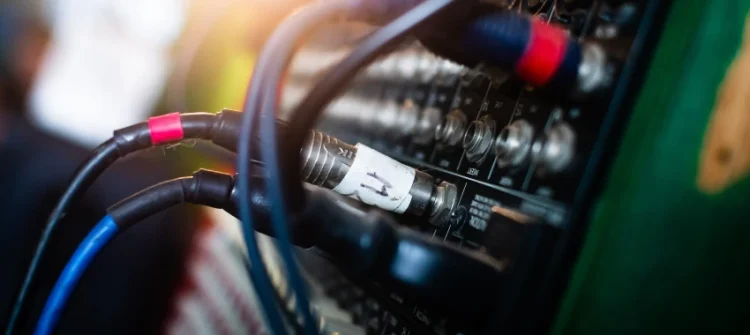
Are you a DJ just starting a DJ career and wondering which audio cables for DJs you need to connect your equipment? Look no further. In this beginners guide, we’ll go over the different types of audio cables and their uses in DJ setups.
- Types of audio cables for DJs
- Balanced and unbalanced cables
Types of audio cables for DJs
Cables are some of the most important accessories for any DJ, and without them, the job becomes complicated and mixing music becomes nearly impossible.
RCA cable
RCA cables are used to connect devices such as turntables and CDJs to a mixer. They are usually color-coded, with red and white connectors for the left and right audio channels, respectively. These cables can be found in most electronics stores and are relatively inexpensive.
This cable is used in a variety of applications. Since RCA cables are not balanced, they are best used over short distances.
XLR cable
The industry standard for connecting professional audio gear like mixers is the use of XLR cables. These cables have a more reliable locking mechanism and last longer than RCA ones. Also, you can choose the length that works best for your installation from among several options.
In professional audio, XLR cables are a common cable format. Unlike most other DJ audio cables, they usually have two ends, one male and one female.
The inputs and outputs are used for the primary outputs of mixing consoles or high-end controllers, as well as for microphones.
They are balanced, lock into position, making accidental disconnection difficult, and it is easy to join a series of shorter cables together to obtain a longer run, thanks to the double termination.
TRS/TS cable
These cables are typically used to connect instruments, such as electric guitars and keyboards, to a mixer. They look and feel similar to a headphone jack and can also be found in most electronics stores.
Along with TS, which stands for Tip Sleeve, TRS is short for Tip Ring Sleeve. The TRS connector is the most common connector and is usually found as a 1/8″ or 1/4″ plug on headphones.
It is also common practice to use these cables when connecting PA speakers, microphones, and instrument patch cables. They are used as main or booth outputs out of the headphones.
These cables are available in balanced and unbalanced versions. To put it simply, TRS cables are balanced, while TS cables are not. To differentiate between them, a TRS cable has an additional plastic ring around the plug, while TS cables have only one.
USB cable
USB DJ cables are used to connect devices such as laptops and controllers to a mixing desk. They are essential for DJs who use digital music software, such as Traktor or Serato, in their performances.
Balanced and unbalanced cables
In the DJ industry, balanced and unbalanced cables are used to connect audio equipment such as turntables, CDJs and mixers.
The main difference between balanced and unbalanced audio cables is how they handle interference, and this can be an important consideration for DJs.
Unbalanced cables (RCA, TS)
Unbalanced cables use two conductors: a signal conductor and a ground conductor. The signal is carried on the signal conductor, while the ground conductor provides a return path for the signal. This type of cable is commonly used for short cable runs, and is typically less expensive than balanced cables.
These are typically used to connect turntables to a mixer or CDJs to a mixer. These DJ cables feature a separate audio signal conductor and ground wire.
Because of their easy design and lower cost they tend to be highly sought after. However, they are susceptible to interference and noise, especially on long runs or in environments with high levels of electromagnetic interference.
Balanced cables (XLR, TRS)
Balanced cables use three conductors: a signal conductor, a ground conductor, and a third conductor that carries an inverted copy of the signal. This inverted signal is then combined with the original signal at the receiving end, which cancels out any interference that may have been picked up along the way.
This makes balanced cables ideal for longer cable runs, and for use in environments with a lot of electronic interference. Balanced cables are typically more expensive than unbalanced cables, but they offer higher quality sound and are less susceptible to noise and hum.
For example, they are used to connect mixing consoles to amplifiers or loudspeakers. These cables have three conductors: two for the audio signal (hot and cold) and one for ground.
DJs should be aware that balanced cables offer better audio quality and interference protection than unbalanced cables, but it is important to make sure that all equipment is compatible with the type of cable being used.
Also, if you are using balanced cables, make sure that your equipment is configured to work with them; otherwise, the audio quality will not be optimal.
If you know the different types of audio cables and dj connectors and their uses, you will be able to create a smooth and professional DJ experience. And if you don’t know where to find your next gig, take a look at what Wavezoo has to offer!
Subscribe to our newsletter 🎧

